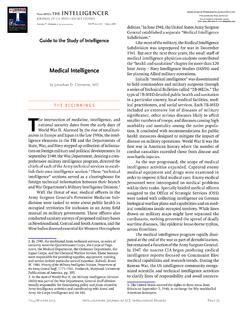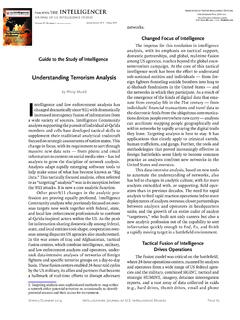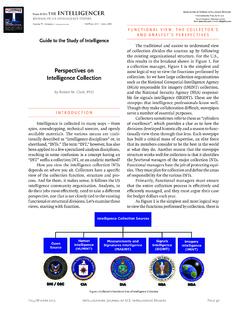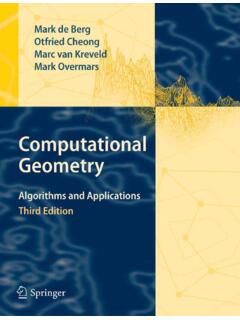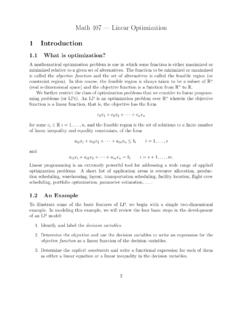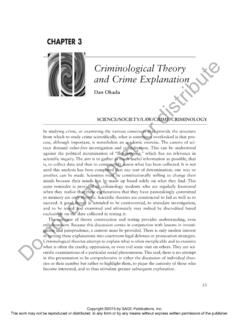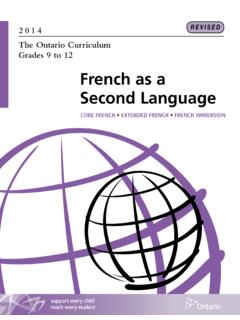Transcription of What is Counterintelligence? - AFIO
1 From AFIO's The Intelligencer Association of Former Intelligence Officers 7700 Leesburg Pike, Suite 324. Journal of Intelligence Studies Falls Church, Virginia 22043. Web: , E-mail: Volume 20 Number 2 $15 single copy price Fall/Winter 2013 2013, AFIO. measure what an adversary knows about us? How do we determine whether or not we are successful in keeping our secrets and projecting the image we wish Guide to the Study of Intelligence to project? How do we know what and whom to trust?3. This article is a short cut to some basic concepts about counterintelligence: what it is and is not. Educa- tors in history, government, political science, ethics, law and cognitive psychology should consider whether and how lessons on counterintelligence might enrich What is Counterintelligence? their courses. Recommended additional readings are suggested in the footnotes. A Guide to Thinking A general introductory course on counter- and Teaching about CI intelligence should have five key learning objectives: Understanding the meaning of counterintelli- gence, its place within intelligence studies, and by Michelle K.
2 Van Cleave its role in international relations as an instrument of Understanding the difference between tactical WHY STUDY COUNTERINTELLIGENCE? and strategic CI,5 the difference between CI and security,6 and the range of foreign intelligence T. he study of counterintelligence is rare in aca- 3. Consider for example the deception paradox: Alertness to demia. While modern courses on international deception presumably prompts a more careful and systematic review of the evidence. But anticipation of deception also leads relations often include intelligence, they usually the analyst to be more skeptical of all of the evidence, and to fail to consider how countering foreign intelligence the extent that evidence is deemed unreliable, the analyst's activities is also an instrument of state power. No preconceptions must play a greater role in determining which evidence to believe. This leads to a paradox: The more alert we inquiry into intelligence theory or practice is complete are to deception, the more likely we are to be deceived.
3 Michael without addressing the meaning and scope of coun- I. Handel, Intelligence and Deception in Roger Z. George and What is the value of intelligence if you Robert D. Kline, eds, Intelligence and the National Security Strategist: cannot assess its reliability or truth? Enduring Issues and Challenges (Washington, DC: National Defense University Press, 2004), 379, quoting Richards Heuer, Strategic Counterintelligence (CI) is intertwined with our Deception: A Psychological Perspective a paper presented at the history, laws and ethics, and major espionage cases 21st Annual Convention of the International Studies Associ- have affected American society and politics from ation, Los Angeles, California, March 1980, 17, 28. Handel's article is a nice primer on deception: how to do it and how to German saboteurs and communist movements to avoid it. terrorist cells The CI mission that supports 4. CIA Historical Review Program, Counterintelligence for Na- and is governed by our Constitution and democratic tional Security Studies in Intelligence, Vol.
4 2, No. 4, at https://www. institutions is utterly different from that practiced by security states such as the former Soviet Union (and 5. Michelle Van Cleave, The Question of Strategic Counterin- its successor). telligence: What is it, and what should we do about it? Studies in Also, the counterintelligence mindset, its Intelligence, Vol. 51, No. 2, at puzzles and intellectual challenges, stretch the imag- the-study-of-intelligence/csi-publicatio ns/csi-studies/studies/vol51no2/. ination and provide insight into how we think. How 6. Counterintelligence complements but should not be confused do we know what we perceive is correct? How do we with security. Center for the Study of Intelligence, Counterin- telligence for National Security, Studies in Intelligence Vol. 2, No 4, see esp. section entitled Counterintelligence as Activity.. 1. John Ehrman, Toward a Theory of CI: What are We Talking About When We Talk about Counterintelligence?
5 Studies in vol2no4/ The practical objectives of Intelligence, Vol. 53, No 2, (Washington, DC: Center for the Study CI and security are not always in concert which Christopher of Intelligence) at Felix (TN James McCargar) called one of the classic conflicts intelligence/csi-publications/csi-studie s/studies/vol53no2/toward-a-theo- of secret operations. As he explains, [CI] operations are offensive operations which depend for their existence as well 2. Michael J. Sulick, Spying in America: Espionage from the Revolu- as success on constant, if controlled, contact with the enemy. tionary War to the Dawn of the Cold War (Washington DC: George- Security, on the other hand, is a defensive operation which seeks town University Press, 2012). to destroy the enemy's operations and to cut off all contact with Fall/Winter 2013 Intelligencer: Journal of Intelligence Studies Page 57. activities from targeting national security secrets and stood of the intelligence The popular proprietary corporate information to conducting opera- notion is that of catching spies and putting them in tions to influence our policymakers and public attitudes.
6 Jail, but spy catching is only the most visible part of Exploring the history of CI in the United States, a far more complex concept that encompasses all of the roles and missions of government CI orga- the above. CI is arguably also the most essential of the nizations, and how CI functions as an input and intelligence disciplines. Why? Because even if you were tool for national security policymaking and able to collect vast quantities of secret information and produce exquisite analysis, without effective counter- Appreciating the ethical principles, laws and intelligence you could not have confidence in any of it. oversight governing counterintelligence in the With both a national security and homeland United States. security mission CI has defensive and offensive com- Identifying the sub-disciplines of both offensive ponents. It is an instrument of statecraft, just as intel- and defensive CI and the concepts of deception ligence is serving to advance the objectives of nation operations and analysis, double agents and asset states.
7 When successful, CI contributes to national security by serving both as a shield (guarding against penetrations of our government and our allies and W HAT IS CO UNTERINTELLIGENCE? alerting security) and a sword (conducting offensive CI. operations that shape foreign perceptions and degrade foreign intelligence capabilities).11. It is both an intelligence discipline and a national The first clue to understanding counterintelli- security mission and involves gence is in the word itself. What is it that counterin- catching spies and putting them in jail; telligence is counter to or against? If you answered, a set of tactical activities to protect and foreign intelligence threats you are But enable successful intelligence operations; what does that mean? By statute . the national security function that supplies The term counterintelligence means information insights into foreign intelligence threats gathered, and activities conducted, to protect against to the United States, including options to espionage, other intelligence activities, sabotage, or defeat them as national policy may direct; assassinations conducted by or on behalf of foreign gov- ernments or elements thereof, foreign organizations, or and foreign persons, or international terrorist activities.
8 (50. an intellectual exercise of almost mathe- USC 401a). matical complexity 9 Counterintelligence encompasses both infor- Counterintelligence is perhaps the least under- mation and activities. When we collect intelligence him as dangerous. Christopher Felix, A Short course in the Secret 10. For excellent overviews of counterintelligence by two War, 4th ed, (Lanham, Maryland: Madison Books, 2001), 126. former heads of CIA's counterintelligence, see James Olson, The interdependency between CI and the security disciplines has The Ten Commandments of Counterintelligence Studies in In- led to some long-playing theoretical discussions about which telligence, Winter-Spring 2001, at if either may be said to encompass the other; in practice, at a for-the-study-of-intelligence/csi-public ations/csi-studies/studies/fall_win- minimum, the two must be closely linked. ter_2001 ; and Paul Redmond, The Challenges of 7.
9 Michelle Van Cleave, Counterintelligence and National Security Counterintelligence, in The Oxford Handbook of National Security (Washington DC: National Defense University Press, 2007). The Intelligence, Loch Johnson, ed. (New York: Oxford University current article draws heavily from this source. Press, 2010), 537-554. 8. Asset validation is the process used to determine the asset 11. For purposes of simplicity and richness of insights, this authenticity, reliability, utility, suitability and degree of control guide is written from the perspective of counterintelligence. the case officer and others have. (US Department of Defense Other nation states have different counterintelligence practices Joint Publication ) For an understanding of the impor- and histories. tance of asset validation and especially what can go wrong if 12. A note on terminology: You may hear the oxymoron coun- it isn't done right, see the example of Curveball and the Iraq terintelligence threat.
10 This is incorrect in the same way one war, examined by the Commission on the Intelligence Capabil- does not speak of a counterterrorist threat or a counterprolif- ities of the United States Regarding Weapons of Mass Destruc- eration threat; rather they are terrorist or proliferation threats, tion ( WMD Commission ) Laurence H. Silberman and Charles respectively. The correct terminology is a foreign intelligence S. Robb (Co-Chairmen) Report to the President of the United States, threat to which counterintelligence is the response. (Strictly March 31, 2005, Chapter 7; for insight into broader reforms speaking there is such a thing as a CI threat but that refers to needed in counterintelligence, see Chapter 11, available at the narrow case in which the intelligence operation itself must contend with the CI activities of its target or within its theater of 9. Felix, op cit. operations.). Page 58 Intelligencer: Journal of Intelligence Studies Fall/Winter 2013.
